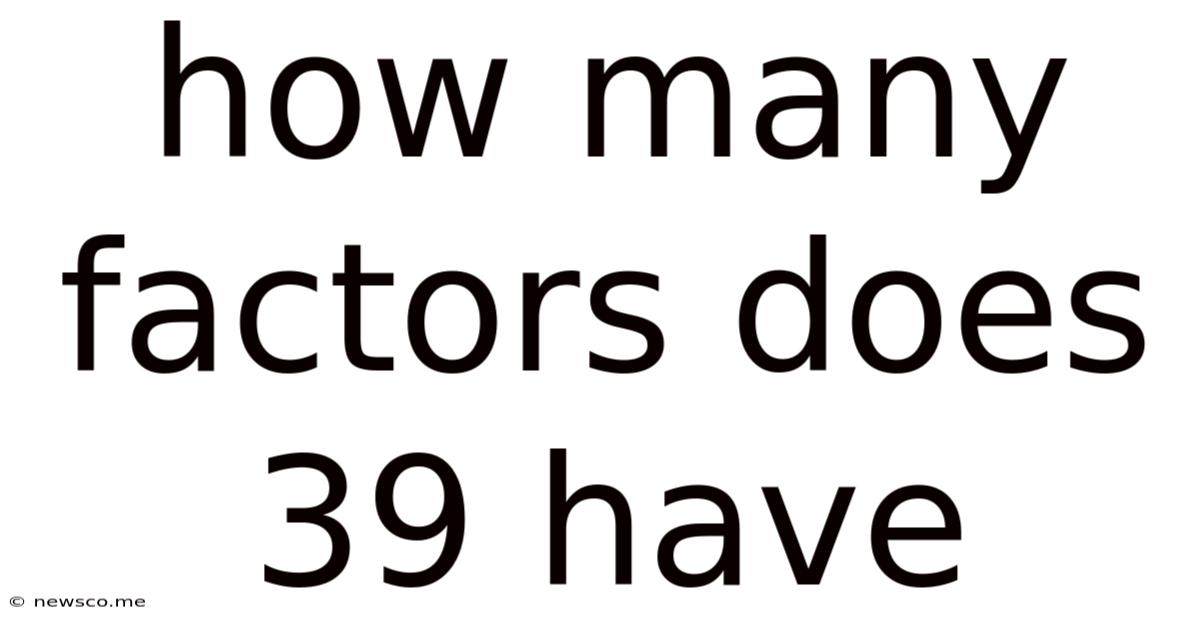How Many Factors Does 39 Have
News Co
May 07, 2025 · 4 min read

Table of Contents
How Many Factors Does 39 Have? A Deep Dive into Number Theory
Finding the factors of a number might seem like a simple arithmetic exercise, but it opens the door to a fascinating world of number theory. This exploration delves into the question: How many factors does 39 have? We'll not only answer this specific question but also equip you with the tools and understanding to tackle similar problems for any number. This involves understanding prime factorization, the relationship between prime factors and the number of factors, and exploring the broader applications of this concept.
Understanding Factors and Divisors
Before we delve into the specifics of 39, let's establish a clear understanding of what we mean by "factors" or "divisors." A factor (or divisor) of a number is any integer that divides the number evenly, leaving no remainder. For example, the factors of 12 are 1, 2, 3, 4, 6, and 12. Each of these numbers divides 12 without leaving a remainder.
Prime Factorization: The Key to Finding Factors
The most efficient method for determining the number of factors of any integer involves prime factorization. Prime factorization is the process of expressing a number as a product of its prime factors. A prime number is a whole number greater than 1 that has only two divisors: 1 and itself. Examples of prime numbers include 2, 3, 5, 7, 11, and so on.
Finding the Prime Factors of 39:
To find the prime factors of 39, we start by dividing it by the smallest prime number, 2. Since 39 is not divisible by 2, we move to the next prime number, 3. 39 divided by 3 is 13, which is also a prime number. Therefore, the prime factorization of 39 is 3 x 13.
Calculating the Number of Factors
Once we have the prime factorization of a number, calculating the total number of factors becomes straightforward. This is where the power of prime factorization truly shines.
The Formula:
If the prime factorization of a number n is given by:
n = p₁<sup>a₁</sup> * p₂<sup>a₂</sup> * p₃<sup>a₃</sup> * ... * p<sub>k</sub><sup>ak</sup>
where p₁, p₂, p₃, ..., p<sub>k</sub> are distinct prime numbers and a₁, a₂, a₃, ..., a<sub>k</sub> are their respective exponents, then the total number of factors of n is given by:
(a₁ + 1)(a₂ + 1)(a₃ + 1)...(a<sub>k</sub> + 1)
Applying the Formula to 39:
The prime factorization of 39 is 3¹ x 13¹. Therefore:
- a₁ = 1 (exponent of 3)
- a₂ = 1 (exponent of 13)
Using the formula, the number of factors of 39 is:
(1 + 1)(1 + 1) = 2 x 2 = 4
Therefore, 39 has four factors.
Listing the Factors of 39
Now that we know 39 has four factors, let's list them explicitly:
- 1: Every number has 1 as a factor.
- 3: 39 is divisible by 3.
- 13: 39 is divisible by 13.
- 39: The number itself is always a factor.
Expanding Our Understanding: Exploring Different Numbers
Let's apply the same principles to other numbers to solidify our understanding:
Example 1: Finding the factors of 24
- Prime Factorization: 24 = 2³ x 3¹
- Number of Factors: (3 + 1)(1 + 1) = 8
- Factors: 1, 2, 3, 4, 6, 8, 12, 24
Example 2: Finding the factors of 100
- Prime Factorization: 100 = 2² x 5²
- Number of Factors: (2 + 1)(2 + 1) = 9
- Factors: 1, 2, 4, 5, 10, 20, 25, 50, 100
Example 3: A Number with Many Factors - 720
- Prime Factorization: 720 = 2⁴ x 3² x 5¹
- Number of Factors: (4 + 1)(2 + 1)(1 + 1) = 30
- Factors: This would be a longer list! The formula makes finding the total number much easier than listing them all.
The Significance of Factorization in Number Theory and Beyond
The concept of prime factorization and finding the number of factors extends far beyond simple arithmetic. It forms a cornerstone of many advanced mathematical concepts, including:
- Cryptography: Prime factorization is crucial in modern cryptography, particularly in RSA encryption, which relies on the difficulty of factoring large numbers into their prime components.
- Modular Arithmetic: Understanding factors is essential in modular arithmetic, used in various applications like computer science and cryptography.
- Abstract Algebra: Prime factorization plays a critical role in abstract algebra, a branch of mathematics dealing with algebraic structures.
Conclusion: More Than Just a Math Problem
Determining how many factors a number has, starting with the seemingly simple question of "How many factors does 39 have?", unveils a deeper appreciation for the fundamental concepts of number theory. The process of prime factorization and the formula for calculating the number of factors offer a powerful and efficient method applicable to any integer. This knowledge extends beyond basic arithmetic and opens doors to more complex mathematical areas, underscoring the practical and theoretical significance of this seemingly simple mathematical concept. The ability to efficiently determine the number of factors of a number is not only valuable for mathematical pursuits but also provides a solid foundation for exploring more advanced topics within number theory and its applications. Remember, understanding the building blocks of mathematics allows for a deeper understanding of the world around us and how these seemingly simple concepts affect complex systems.
Latest Posts
Related Post
Thank you for visiting our website which covers about How Many Factors Does 39 Have . We hope the information provided has been useful to you. Feel free to contact us if you have any questions or need further assistance. See you next time and don't miss to bookmark.